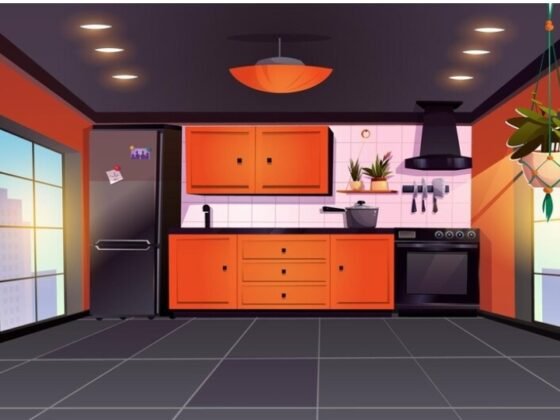The kitchen is the heart of the home, and its layout plays a critical role in determining its functionality and aesthetics. Among the various kitchen designs, the parallel kitchen, also known as a galley kitchen, stands out as a space-efficient and practical option, especially for compact spaces. In this article, we explore the features, benefits, and tips for creating an ideal parallel kitchen design.
What is a Parallel Kitchen?
A parallel kitchen consists of two parallel countertops with a walkway in between. This layout creates a streamlined workspace where everything is within easy reach, making it an excellent choice for both small and medium-sized homes. It is commonly used in apartments or homes with limited kitchen space but can also work well in larger settings with proper planning.
Key Features of a Parallel Kitchen
1. Dual Workstations
The design features two countertops placed opposite each other. One side typically houses the stove and cooking area, while the other may include the sink or storage units. This separation ensures efficiency during meal preparation.
2. Maximized Storage
With cabinets and shelves on both sides, a parallel kitchen provides ample storage options. Overhead and base cabinets can be installed on both walls, utilizing vertical space efficiently.
3. Streamlined Workflow
The layout follows the kitchen work triangle principle — the stove, sink, and refrigerator are positioned to allow smooth and efficient movement.
4. Space Optimization
Parallel kitchens make excellent use of limited space. The layout is narrow and compact, yet it provides enough room for two or three people to work comfortably.
Benefits of a Parallel Kitchen Design
1. Efficiency
The compact arrangement ensures that everything you need is within arm’s reach. This layout minimizes unnecessary movement, saving time and energy while cooking.
2. Cost-Effectiveness
Since parallel kitchens are space-efficient, they often require fewer materials for countertops and cabinetry, making them more affordable than larger layouts like U-shaped or island kitchens.
3. Customizable Storage
With cabinets on both sides, you can customize the storage according to your needs. From pull-out drawers to modular units, the design accommodates a variety of storage solutions.
4. Enhanced Workflow
The separation of work zones — cooking, cleaning, and storage — ensures that multiple people can work simultaneously without interference.
5. Ideal for Small Spaces
For apartments and homes with limited square footage, the parallel kitchen is a practical solution that doesn’t compromise on functionality or style.
Design Tips for an Efficient Parallel Kitchen
1. Maintain Adequate Space Between Countertops
The walkway between the two countertops should ideally be 3 to 4 feet wide. This ensures sufficient room for movement and avoids a cramped feeling.
2. Use Light Colors
To make the kitchen appear more spacious, use light and neutral colors for cabinets and walls. Shades like white, beige, or pastel tones work well in parallel kitchens.
3. Install Proper Lighting
Good lighting is crucial in a parallel kitchen. Use under-cabinet lighting to illuminate the countertops and pendant lights for overall brightness.
4. Maximize Vertical Storage
Utilize the walls by installing tall cabinets or shelves. This helps in storing less frequently used items while keeping the countertops clutter-free.
5. Choose Sliding Doors
If your parallel kitchen leads to another room, consider installing sliding doors to save space and enhance the modern aesthetic.
6. Opt for Built-in Appliances
Built-in ovens, microwaves, and dishwashers help save counter space and give the kitchen a sleek, cohesive look.
Common Challenges and How to Overcome Them
1. Limited Width
The narrow space can feel restrictive, especially in smaller kitchens. Overcome this by using open shelves instead of bulky cabinets on one side.
2. Cluttered Countertops
With limited countertop space, clutter can accumulate quickly. Invest in wall-mounted organizers or hooks to keep items off the counter.
3. Poor Ventilation
Parallel kitchens may lack natural ventilation due to their compact design. Install a good-quality exhaust fan or chimney to ensure proper airflow.
4. Lighting Issues
Insufficient lighting can make the space feel smaller. Use bright, white lights and incorporate reflective surfaces like glossy backsplashes or countertops to enhance brightness.
Creative Ideas for a Stylish Parallel Kitchen
1. Add a Splash of Color
Incorporate a vibrant backsplash or colorful cabinetry to add personality to your kitchen without overwhelming the space.
2. Use Glass Elements
Glass cabinet doors or open shelving can create a sense of openness, making the kitchen feel larger.
3. Integrate Smart Technology
Install smart appliances like touchless faucets or voice-controlled lights to enhance functionality and add a modern touch.
4. Create a Breakfast Counter
If space permits, extend one side of the countertop into a breakfast bar for casual dining or additional workspace.
Is a Parallel Kitchen Right for You?
A parallel kitchen is ideal for individuals or families who value efficiency and organization in their cooking space. It’s particularly suitable for homes with limited square footage, as it offers maximum functionality within a compact design. However, with thoughtful planning, it can also work beautifully in larger spaces, adding a minimalist and modern appeal.
Conclusion
The parallel kitchen design is a perfect blend of functionality, efficiency, and style. Its space-saving layout and customizable features make it a popular choice among homeowners and interior designers. By focusing on smart storage solutions, proper lighting, and thoughtful organization, you can transform your parallel kitchen into a culinary haven.
Whether you’re renovating your kitchen or building a new home, consider the parallel layout for a smart and practical solution that doesn’t compromise on aesthetics.
ChatGPT can make mistakes. Check important info.


